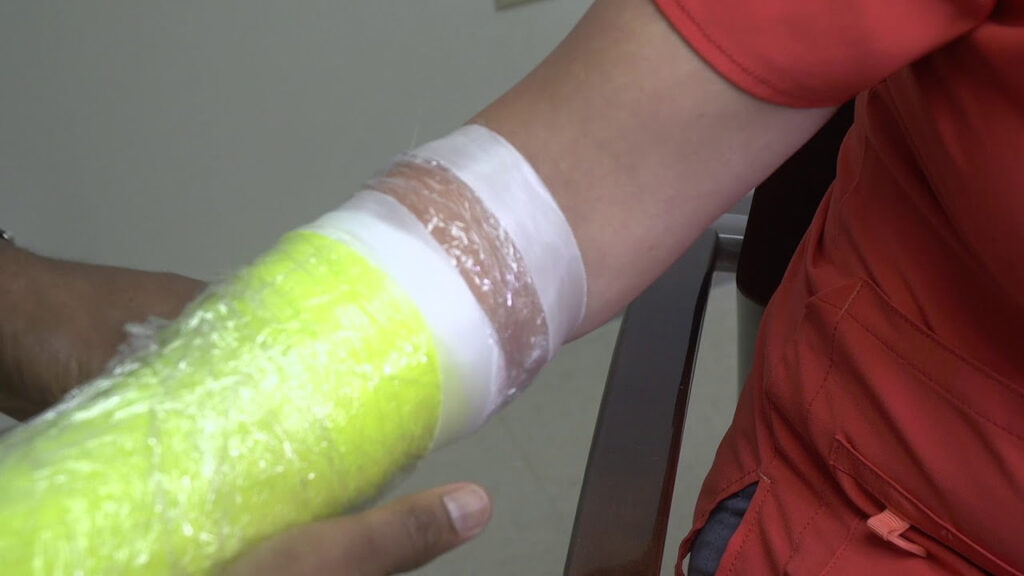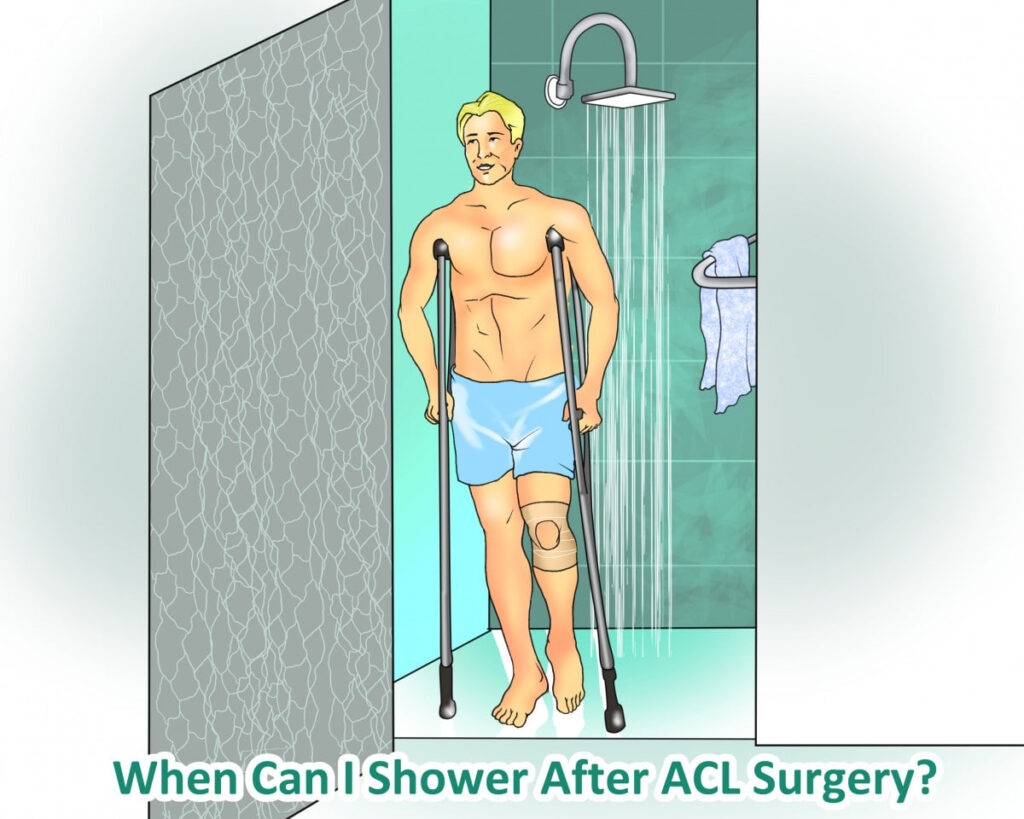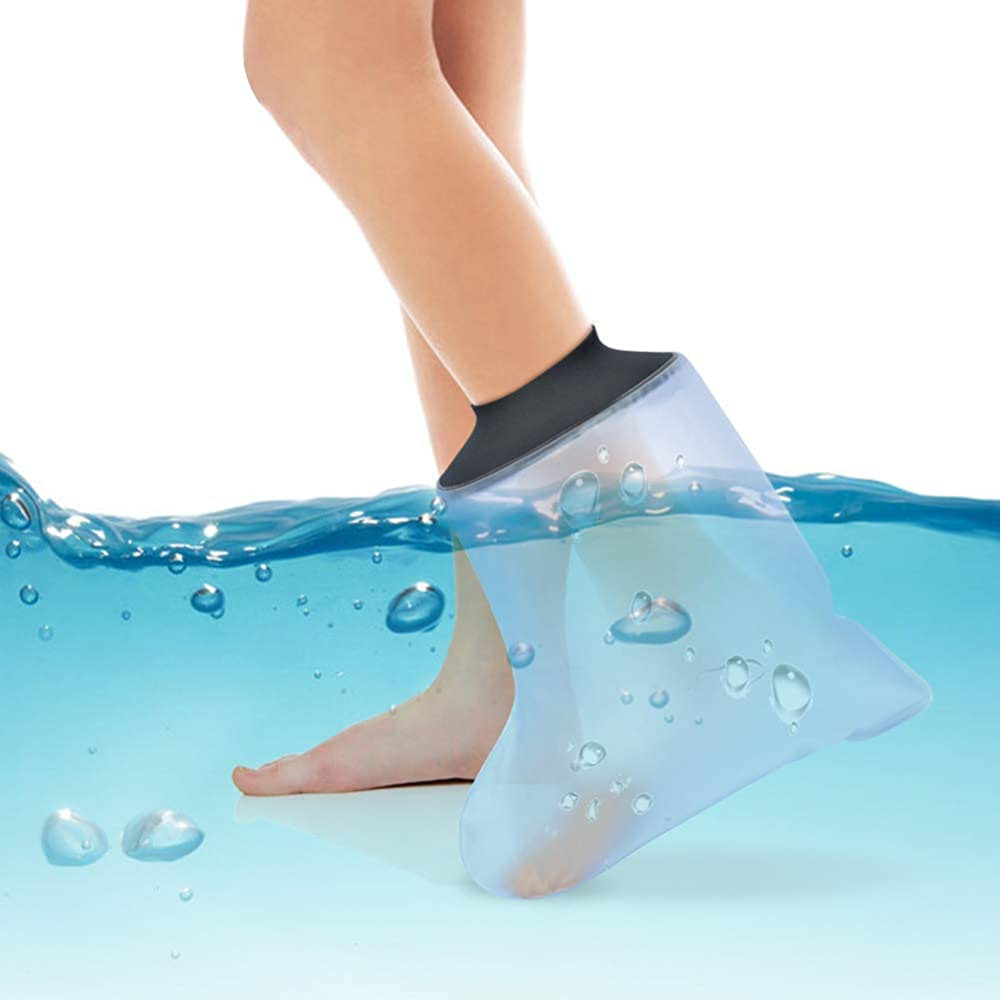With ankle injuries being commonplace in the US and potentially resulting in chronic issues when left untreated, it’s essential for individuals to take ankle pain seriously. Additionally, wearings ankle braces can play an important role in protecting individuals from severe sprains. Broken ankles will naturally require medical treatment and possibly casting, but once the broken bone has healed wearing ankle braces can help with long-term stability. How to shower with a sprained ankle?
In more minor cases of a sprained ankle, special care will be needed while showering while instructions from your doctor should be followed to speed up the recovery process. Ensuring that you wear proper foot wear and apparel (like ankle braces) before any physical activity is especially important and can help reduce the chances of suffering a serious injury like a sprain or broken bone.

Symptoms of an Ankle Sprain
From tenderness to bruising, ankle sprains can be painful and have a variety of telltale signs. Be aware if you experience any swelling around your ankles or difficulty bearing weight – these could signal that a sprain has occurred!
- Unexpected agony can strike after performing the simple motion of rolling or twisting an ankle, leaving even avid athletes sidelined.
- Discolored, painful reminders of a fall or intense encounter, bruises can be the result of simple slips and trips as well as more serious injuries. Whether they serve to remind us that we should take it easy on our next skateboard trick or simply act as colorful stories for conversations with friends, these tender souvenirs are unavoidable parts of life.
- As our bodies are constantly changing, sometimes we notice an increase in size – be it through swelling or bloating. It can be a sign of the body’s response to something, so if you see anything out of place don’t hesitate to speak up!
- A gentle caress brings out a warmth and softness that leaves the soul feeling content.
- Stubbornly limping along, her mobility had been severely hampered by an inability to walk with ease.
- Lingering pain and swelling that won’t go away after a couple of days can be an indication of something more serious. Don’t ignore it; seek medical advice quickly!
- The ankle joint has been restricted, putting a damper on everyday activities. Limited flexibility and mobility can make it difficult or impossible to pursue hobbies such as sports or dance that require agility of the feet.
- A strange sensation of lack in the ankle – numbness and weakness, making it difficult to move as one normally would.
- The affected leg could not bear the burden of weight, leaving movement an insurmountable challenge.
- This area is experiencing a chilling effect on its blood flow, reducing the vibrancy and life of the zone.
If you think your ankle might be more than a simple sprain, don’t take any chances – get it checked out by a medical professional right away.

How to Shower With a Sprained Ankle
After leaving the hospital equipped with a mobility device, you can soon get around your home to rest and heal. Unfortunately though, not every part of your living space is prepared for an ankle sprain or fracture – especially when it comes to navigating the bathroom!
Navigating even a mundane task like showering can become difficult with an injury and large cast. To make sure you’re given the safest cleaning experience, take heed of your doctor’s advice in addition to expert tips presented here depending on which type of footgear you are wearing: either a supportive boot or cumbersome cast!
Get an Assistant
In order to stay safe in the shower, it’s important to bring someone with you. Your balance may be a bit unsteady while adjusting at first – having some extra help will make your transition easy and comfortable for all involved!
Avoid Full Showers
Instead of battling the annoyance that comes with wrapping a cast or boot in plastic just to take a shower, why not try sitting down while you bathe? That way your foot is easily elevated and stays dry. If seated showers aren’t an option, having someone help you into the tub can also be beneficial – simply rest your ankle against the side so it doesn’t get soaked! Afterward they’ll come back to lend assistance getting out again as well.

Take a Seated Shower
Take the hassle and pain out of showering! Transform your bathroom into a spa-like oasis with the addition of a plastic stool or lawn chair, placed conveniently in the center. You’ll find yourself luxuriating beneath your warm spray no matter how bad that sprained ankle is – keeping all body washers, shampoos and conditioners within easy reach makes it even easier to relax!
Keep your casts and boots waterproof with this simple trick! Get a large plastic bag such as what you’d find in the kitchen or garbage. Wrap it around, then seal shut at the top – no duct tape necessary for easy removal later on.
Get ready for a therapeutic experience – take the time to indulge in a luxurious shower. Sit back and relax as the hot water cascades down your body, rejuvenating you from within. When done, make sure to dry off with an absorbent towel before safely removing the plastic bag that brought joy during this blissful moment!
Clean Your Boot or Cast
After a refreshing shower, why not treat your cast or boot in the same way? Make sure to use caution by mixing just one part of bleach with ten parts water – creating the perfect mild cleaning solution that eliminates any pesky germs. All that’s left is to take a clean towel and give it a good scrubbing until dry!
Other Ways to Speed Up the Recovery Time
Healing a sprained ankle doesn’t have to be daunting! While therapeutic showers are beneficial, there are plenty of other home remedies that can help you get back on track in no time. Try these easy solutions – they’ll take the pain away and make your recovery journey much smoother!
1. RICE
An age-old remedy for minor muscle sprains and strains, R.I.C.E., is a mainstay of both traditional medicine and the athletic world: Rest to reduce swelling, Ice to ease pain and inflammation, Compression as an additional layer of support against further damage from movement or activity; Elevation encourages blood flow away from the injured area – simple yet effective!
- To ensure a speedy recovery, make sure to give your body the break it needs! Take some time away from activity and nurture yourself with restful days of relaxation.
- To soothe a sprained ankle, use ice to your advantage – applying cold cubes of relief multiple times daily will help reduce pain and swelling.
- If you’ve been injured and are lacking boots or a cast, wrap the affected area in an elastic or static bandage to reduce swelling quickly.
- Elevation: For an injury, try to keep your ankle at a higher level than the rest of your body – it can make all the difference in reducing fluid build-up and providing relief.
Recover from an ankle sprain faster with RICE therapy! This straightforward yet effective approach can help you manage the inflammation caused by a sprain and get back to your routine quickly. Start it as soon after injury as possible for the best results.
2. Epsom Salt
Soaking your injured ankle in a warm bath of Epsom salt can be an effective way to soothe sore muscles, reduce joint stiffness, and support the healing process. Cold baths should be used as soon as possible after the injury followed by 1-2 weekly Epsom salt treatments for optimal comfort and recovery.
3. Natural Poultices
Soaking your injured ankle in a warm bath of Epsom salt can be an effective way to soothe sore muscles, reduce joint stiffness, and support the healing process. Cold baths should be used as soon as possible after the injury followed by 1-2 weekly Epsom salt treatments for optimal comfort and recovery.
4. Cold Compression Therapy
Bypass the ice pack and upgrade your at-home RICE therapy with a cold and compression treatment! Elevate your injury recovery by utilizing cutting edge technology such as air compressions combined with cooled water in body-conforming wraps. Reap all of the benefits that come from traditional RICE therapy but experience them to an upgraded degree.
Enjoy the healing power of hydrotherapy with your sprained ankle! As water circulates at a consistent temperature around it, pressurized air creates an invigorating “squeeze and release” effect that helps reduce swelling. Relax as you benefit from natural therapeutic relief in just one session.
5. OTC Pain Medication
A sprained ankle can be debilitating and agonizing, but relief is possible. Although it may seem like an unbearable struggle at times, over-the-counter pain medication could provide some much needed respite – just remember to always follow your physician’s prescribed dosage instructions for safe usage!
Frequently Asked Questions About Sprained Ankles
Questions about ankle sprains are common. How long should I expect recovery to take? Can anything be done to accelerate healing? These queries come up often, and people need guidance on how best to care for their injury.
How long does it take to heal from a sprained ankle?
Healing from a sprained ankle is not one-size-fits all, as many factors play into how quickly the healing process will go. The severity of the injury and your treatment approach are major determinants for time spent recovering, but rest and overall health also have an impact on recovery speed. Generally speaking however, most people can expect to spend anywhere between three days to several weeks in rehabilitation!
- Spraining an ankle can be painful and put a damper on your plans, but those with mild sprains have something to look forward to: Relief in just 1-2 weeks!
- A moderate ankle sprain can take anywhere from four to six weeks to heal, so it’s important you give yourself the necessary time and patience for a full recovery.
- Recovering from a severe ankle sprain can be an arduous journey, with the healing process typically taking 8-12 weeks. However, if you commit to following your doctor’s advice and doing physical therapy exercises as directed, you will eventually experience renewed strength and stability in your joint.
A severe ankle sprain can be a tough challenge to overcome, possibly requiring intense physical therapy or even surgery in order to heal properly.
How long do you need to stay off a sprained ankle?
Even when injury strikes, life must go on. If you have sprained ligaments in your ankle and need to get around, make sure you give them time to heal by using crutches for a handful of days before switching over to a rigid boot brace if needed. Keep the weight off hurting ankles at all times with supportive footwear; however, don’t hesitate getting medical attention should any complications arise or an inability move about persists beyond several days.
How can I make a sprained ankle heal faster?
An ankle sprain can be a roadblock to physical well-being. But with some simple treatments, you may support the necessary healing process. Elevating and immobilizing your foot as much as possible during rest will ensure an effective recovery – but don’t forget about diet and sleep too! A healthy balance of both supports that vital journey back to good health.
Can I walk on a sprained ankle?
If your ankle is causing you extreme agony, don’t push through it! Give yourself some TLC by taking a few days off and relying on crutches for support. As healing takes place, use an ankle boot or brace to provide extra stability while transitioning back into activities until walking with ease becomes the new normal. Then steer clear of running or any other intense physical exertion that could potentially cause a setback in recovery time.
Wrapping Up
For those with a sprained ankle, the weekly shower cycle can be very daunting. When you suffer from a severe sprain or broken ankle, the pressure of standing in the tub can cause even more pain and discomfort. Thankfully, there are simple solutions like wear ankle braces or using therapeutic handheld showerheads that ease the process, making it simpler and more comfortable.
Moreover, incorporating pain relief techniques such as aromatherapy, warm water immersion and taking your time during showers can help reduce your recovery time significantly. If your condition persists beyond home remedies, feel free to consult with a physician who will provide tailored advice and guide you back to good health.
Read more: How to clean brushed nickle? fixtures

